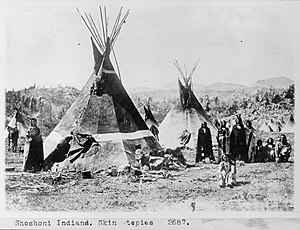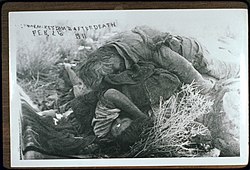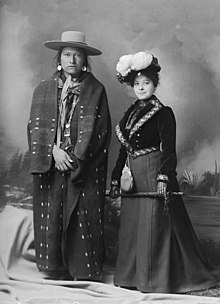Type a search term to find related articles by LIMS subject matter experts gathered from the most trusted and dynamic collaboration tools in the laboratory informatics industry.
Newe | |
|---|---|
| Total population | |
| 12,300 (2000) | |
| Regions with significant populations | |
| United States (Idaho, California, Nevada, Oregon, Utah, Wyoming) | |
| Languages | |
| Shoshone,[1] English | |
| Religion | |
| Native American Church, Sun Dance, traditional tribal religion,[2] Christianity, Ghost Dance | |
| Related ethnic groups | |
| Timbisha and Comanche |
The Shoshone or Shoshoni (/ʃoʊˈʃoʊni/ shoh-SHOH-nee or /ʃəˈʃoʊni/ shə-SHOH-nee) are a Native American tribe with four large cultural/linguistic divisions:
They traditionally speak the Shoshoni language, part of the Numic languages branch of the large Uto-Aztecan language family. The Shoshone were sometimes called the Snake Indians by neighboring tribes and early American explorers.[2]
Their peoples have become members of federally recognized tribes throughout their traditional areas of settlement, often co-located with the Northern Paiute people of the Great Basin.
The name "Shoshone" comes from Sosoni, a Shoshone word for high-growing grasses. Some neighboring tribes call the Shoshone "Grass House People," based on their traditional homes made from sosoni. Shoshones call themselves Newe, meaning "People".[2]
Meriwether Lewis recorded the tribe as the "Sosonees or snake Indians" in 1805.[2]
The Shoshoni language is spoken by approximately 1,000 people today.[1] It belongs to the Central Numic branch of the Uto-Aztecan language family. Speakers are scattered from central Nevada to central Wyoming.[1]
The largest numbers of Shoshoni speakers live on the federally recognized Duck Valley Indian Reservation, located on the border of Nevada and Idaho; and Goshute Reservation in Utah. Idaho State University also offers Shoshoni-language classes.[1]





The Shoshone are a Native American tribe that originated in the western Great Basin and spread north and east into present-day Idaho and Wyoming. By 1500, some Eastern Shoshone had crossed the Rocky Mountains into the Great Plains. After 1750, warfare and pressure from the Blackfoot, Crow, Lakota, Cheyenne, and Arapaho pushed Eastern Shoshone south and westward. Some of them moved as far south as Texas, emerging as the Comanche by 1700.[2]
As more European American settlers migrated west, tensions rose with the indigenous people over competition for territory and resources. Wars occurred throughout the second half of the 19th century. The Northern Shoshone, led by Chief Pocatello, fought during the 1860s against settlers in Idaho (where the city Pocatello was named for him). As more settlers encroached on Shoshone hunting territory, the natives raided farms and ranches for food and attacked immigrants.
The warfare resulted in the Bear River Massacre (1863) when U.S. forces attacked and killed an estimated 250 Northwestern Shoshone, who were at their winter encampment in present-day Franklin County, Idaho. A large number of the dead were non-combatants, including children, deliberately killed by the soldiers. This was the highest number of deaths which the Shoshone suffered at the hands of United States forces. 21 US soldiers were also killed.[5]
During the American Civil War travelers continued to migrate westward along the Westward Expansion Trails. When the Shoshone, along with the Utes participated in attacks on the mail route that ran west out of Fort Laramie, the mail route had to be relocated south of the trail through Wyoming.[6]
Allied with the Bannock, to whom they were related, the Shoshone fought against the United States in the Snake War from 1864 to 1868. They fought U.S. forces together in 1878 in the Bannock War. In 1876, by contrast, the Shoshone fought alongside the U.S. Army in the Battle of the Rosebud against their traditional enemies, the Lakota and Cheyenne.
In 1879 a band of approximately 300 Eastern Shoshone (known as "Sheepeaters") became involved in the Sheepeater Indian War. It was the last Indian war fought in the Pacific Northwest region of the present-day United States.
In 1911 a small group of Bannock under a leader named Mike Daggett, also known as "Shoshone Mike," killed four ranchers in Washoe County, Nevada.[7] The settlers formed a posse and went out after the Native Americans. They caught up with the Bannock band on February 25, 1911, and in a gun battle killed Mike Daggett and seven members of his band. They lost one man of the posse, Ed Hogle[8] in the Battle of Kelley Creek. The posse captured a baby, two children and a young woman. (The three older captives died of diseases within a year; the baby, Mary Jo Estep, died in 1992).
A rancher donated the partial remains of three adult males, two adult females, two adolescent males, and three children (believed to be Mike Daggett and his family, according to contemporary accounts) to the Smithsonian Institution in Washington, D.C., for study. In 1994, the institution repatriated the remains to the Fort Hall Idaho Shoshone-Bannock Tribe.[9]
In 2008 the Northwestern Band of the Shoshone Nation acquired the site of the Bear River Massacre and some surrounding land. They wanted to protect the holy land and to build a memorial to the massacre, the largest their nation had suffered. "In partnership with the American West Heritage Center and state leaders in Idaho and Utah, the tribe has developed public/private partnerships to advance tribal cultural preservation and economic development goals." They have become leaders in developing tribal renewable energy.[10]
The Shoshone were scattered over a vast area and divided into many bands, therefore many estimates of their population did not cover the entire tribe. In 1820 Jedidiah Morse estimated the Shoshone population at 60,000 and 20,000 Eastern Shoshone.[11] According to Alexander Ross the Shoshone were on the west side of the Rocky Mountains what the Sioux were on the east side - the most powerful tribe - and he estimated that in 1855 the Shoshone numbered 36,000 people.[12] They were much reduced in number after they had suffered infectious disease epidemics and warfare. According to Joseph Lane the Shoshone were divided into many bands and it was almost impossible to ascertain their exact numbers. According to Indian Affairs 1859 in Utah there were 4,500 Shoshones. Indian Affairs 1866 reported in Utah 4,500 eastern Bannock and Shoshone intermingled and 3,800 western and northwestern Shoshone as well as 2,000 Shoshone in Nevada and 2,500 Shoshone in Idaho, as well as an unspecified number in Oregon. The completion of the first transcontinental railroad in 1869 was followed by European-American immigrants arriving in unprecedented numbers in the territory. Indian Affairs 1875 gave the Shoshone as 1,740 in Idaho and Montana, 1,945 in Nevada, 700 in Wyoming and 244 (besides those intermixed with the Bannock) in Oregon. The census of 1910 returned 3,840 Shoshone.[13] In 1937, the Bureau of Indian Affairs counted 3,650 Northern Shoshone and 1,201 Western Shoshone. As of the 2000 U.S. census, some 12,000 persons identified as Shoshone. As of 2020 there were in the USA 17,918 Shoshone including 3,638 in Nevada and 3,491 in Wyoming.[14]
Shoshone people are divided into traditional bands based both on their homelands and primary food sources. These include:

